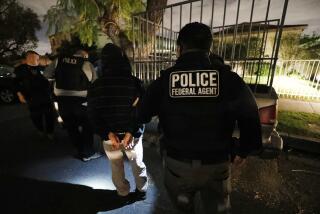Army Announces Plan to Illuminate Border : Immigration: Floodlights along a 13-mile strip would deter smugglers and illegal crossings, military says.
- Share via
SAN DIEGO — The U.S. Army Corps of Engineers announced plans Wednesday to erect scores of floodlights along a 13-mile strip of the U.S.-Mexico border to deter drug smugglers and illegal immigrants.
The proposal calls for raising 150 poles up to 60 feet tall that would support banks of lights and power lines, an Army spokesman said. The concrete and wooden poles would be installed on the north side of the international border, beginning about a mile inland from the Pacific Ocean. The lights would stretch to the San Ysidro Mountains about a mile east of the Otay Mesa Port of Entry.
The project, if approved, would be the latest in a series of federally funded programs to curb border crossings by undocumented migrants and smugglers, said Phil Reidinger, spokesman for the Army’s joint task force working on law enforcement problems at the border.
The lighting would be strung across residential, farm and brush land that has become the most heavily trafficked border crossing in the world. Groupings of five to 16 light poles would be spaced 200 to 400 feet apart, leaving “a few gaps” of darkness over rugged terrain where access by construction workers is limited, Reidinger said.
Each bank of lights uses four bulbs, either 400- or 1,000-watt high-pressure sodium floodlights. South-facing lights would be shielded by bulletproof armor. The brightness would be comparable to a night-lit parking lot, Reidinger said.
The lighting system is designed to back up the 10-foot high, 11-mile-long fence in the Otay Mesa-San Ysidro area. The fence, completed this year, was commissioned by the task force in 1990 after President Bush enlisted the Defense Department in the so-called war against drugs, said Patrick Buechner, an aide to Rep. Duncan Hunter (R-Coronado), whose district includes the entire California-Mexico border.
In March, 1990, Hunter proposed lighting the border to deter drug trafficking, Buechner said. The Bush Administration later earmarked $704,000 for projects to improve lighting on the border, Buechner said.
On Oct. 1, the Corps of Engineers will begin assessing public reaction to the lighting plan and then submit the proposal to the Defense Department for approval.
Last week, the California Coastal Commission began a two-month study on the environmental impact of the project. The commission grants permission for construction projects along the coast.
In the past, anti-immigrant activists drew government attention to illegal crossings with “Light Up the Border” rallies. Hundreds of people parked their cars along the border and pointed their headlights toward Mexico in a gesture of protest of undocumented migrants. After eight monthly gatherings, the spectacle ended in June, 1990, when the INS commissioned banks of floodlights at heavily traveled crossing sites.
Immigration and Naturalization Service officials said that running lights along the length of the new fence will help deter illegal crossing and smuggling.
Since the fence went up, seizures of narcotics have increased at the border, Border Patrol spokesman Randy Warrick said. Illegal vehicle crossings in areas blocked by the fence have been brought to a virtual halt, the INS reported earlier this year.
Still, illegal foot traffic remains heavy: Each year about half a million people cross over illegally from Mexico, according to Border Patrol records. About 225,000 were captured and returned to Mexico from San Diego County last year.
Immigrant rights activists say the proposal compounds the atmosphere of militarization on the U.S. side of the border.
They say the lighting, like the fence, will not deter people who are determined to enter the country illegally.
“Even if you can see every person coming across the border, it makes no difference if you don’t have the personnel to stop them,” said Andrea Skorepa, executive director of Casa Familiar, a social service center in San Ysidro.
Since the fence went up, many smugglers and illegal immigrants have simply moved east.
More to Read
Sign up for Essential California
The most important California stories and recommendations in your inbox every morning.
You may occasionally receive promotional content from the Los Angeles Times.










